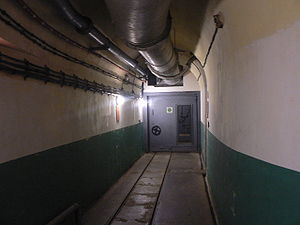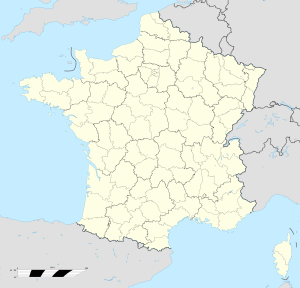- Ouvrage Saint-Gobain
-
Ouvrage Saint-Gobain Part of Maginot Line, Alpine Line Southeast France 
Interior gallery, 60 cm rail line and blast doorCoordinates 45°12′29″N 6°40′55″E / 45.20818°N 6.68186°ECoordinates: 45°12′29″N 6°40′55″E / 45.20818°N 6.68186°E Built 1931 Built by CORF Construction
materialsConcrete, steel, rock excavation In use Preserved Open to
the publicYes Controlled by France Battles/wars Italian invasion of France Ouvrage Saint-Gobain Type of work: Large artillery work (Gros ouvrage) sector
└─sub-sectorFortified Sector of Savoy
└─Moyenne-Maurienne, Quartier de l'ArcRegiment: 71st Batailllon Alpin de Fortresse, 164th Régiment d'Artillerie de Position Number of blocks: 5 Strength: 5 officers, 149 men Ouvrage Saint-Gobain is a work (gros ouvrage) of the Maginot Line's Alpine extension, the Alpine Line. The ouvrage consists of one entry block, one infantry block, one artillery block, one observation block and one combination block. Located in Modane, France, it is just across the valley of the Arc from Ouvrage Saint-Antoine and somewhat to the east of Ouvrage Sapey.
The ouvrage covers the approach to the Fréjus Rail Tunnel and the N6 road. In 1940 it had a garrison of 154 under Captain Dutrey.[1]It cost 12.2 million francs.[2]
Contents
Description
- Block 1 (artillery): one machine gun cloche and one 81mm mortar embrasure.[3]
- Block 2 (artillery): one machine gun cloche, cone heavy twin machine gun cloche two81mm mortar embrasures, one heavy twin machine gun embrasure and one heavy twin machine gun/47mm anti-tank gun embrasure.[4]
- Block 3 (observation): one machine gun cloche, one machine gun embrasure and one observation embrasure.[5]
- Block 4 (infantry): one machine gun cloche, one heavy twin machine gun embrasure.[6]
- Entry: one machine gun cloche, one heavy twin machine gun/37mm anti-tank gun embrasure.[7]
History
Saint-Gobain participated in artillery fire directed at Italian troops in the Italian invasion of France in 1940 only indirectly, when one of its observation blocks spotted the fall of shot from Ouvrage Sapey in the morning hours of June21 against an Italian observation post.[8]
After the 1940 armistice, Italian forces occupied the Alpine ouvrages and disarmed them. In August 1943, southern France was occupied by the German 19th Army, which took over many of the Alpine positions that had been occupied by the Italians until Italy's withdrawal from the war in September 1943.
In 1944, Saint-Gobain was recaptured relatively easily on 13 September.[9] The Modane end of the Fréjus Tunnel was blown up by the retreating Germans, leaving a tilted blockhouse by the railway line, now known as the "Tilted House."[10] Saint-Gobain had suffered little damage during the war and by the end of 1944 was partly repaired and placed into service. Immediately after the war, the Maurienne region was regarded as an area of medium priority for restoration and reuse by the military. By the 1950s the positions in the Southeast of France were restored and operational again. However, by 1960, with France's acquisition of nuclear weapons, the cost and effectiveness of the Maginot system was called into question. Between 1964 and 1971 nearly all of the Maginot fortifications were deactivated.[11]
Ouvrage Saint-Gobain is open for public visitation, maintained by the Association du Musée de la Traverse des Alpes..[12][10]
See also
- List of Alpine Line ouvrages
- Fort du Replaton
References
- ^ Mary, Tome 5, pp. 16–17
- ^ Mary, Tome 4, p. 29
- ^ Puelinckx, Jean; Aublet, Jean-Louis & Mainguin, Sylvie (2010). "Saint-Gobain (go de) Bloc 1" (in French). Index de la Ligne Maginot. fortiff.be. http://www.fortiff.be/maginot/index.php?p=5553. Retrieved 11 February 2010.
- ^ Puelinckx, Jean; et al (2010). "Saint-Gobain (go de) Bloc 2" (in French). Index de la Ligne Maginot. fortiff.be. http://www.fortiff.be/maginot/index.php?p=5554. Retrieved 11 February 2010.
- ^ Puelinckx, Jean; et al (2010). "Saint-Gobain (go de) Bloc 3" (in French). Index de la Ligne Maginot. fortiff.be. http://www.fortiff.be/maginot/index.php?p=5555. Retrieved 11 February 2010.
- ^ Puelinckx, Jean; et al (2010). "Saint-Gobain (go de) Bloc 4" (in French). Index de la Ligne Maginot. fortiff.be. http://www.fortiff.be/maginot/index.php?p=5556. Retrieved 11 February 2010.
- ^ Puelinckx, Jean; et al (2010). "Saint-Gobain (go de) Bloc 5" (in French). Index de la Ligne Maginot. fortiff.be. http://www.fortiff.be/maginot/index.php?p=5556. Retrieved 11 February 2010.
- ^ Mary, Tome 5, p. 98
- ^ Mary, Tome 5, p.147
- ^ a b Kaufmann 2011, p. 258
- ^ Mary, Tome 5, pp.164-175
- ^ "Monuments" (in French). Mairie de Modane. http://www.modane-valfrejus.com/www-liste_monuments-37-FR-decouverte_et_tourisme.html. Retrieved 11 February 2010.
Bibliography
- Allcorn, William. The Maginot Line 1928-45. Oxford: Osprey Publishing, 2003. ISBN 1-84176-646-1
- Kaufmann, J.E. and Kaufmann, H.W. Fortress France: The Maginot Line and French Defenses in World War II, Stackpole Books, 2006. ISBN 0-275-98345-5
- Kaufmann, J.E. , Kaufmann, H.W., Jancovič-Potočnik, A. and Lang, P. The Maginot Line: History and Guide, Pen and Sword, 2011. ISBN 978-1-84884-068-3
- Mary, Jean-Yves; Hohnadel, Alain; Sicard, Jacques. Hommes et Ouvrages de la Ligne Maginot, Tome 1. Paris, Histoire & Collections, 2001. ISBN 2-908182-88-2 (French)
- Mary, Jean-Yves; Hohnadel, Alain; Sicard, Jacques. Hommes et Ouvrages de la Ligne Maginot, Tome 4 - La fortification alpine. Paris, Histoire & Collections, 2009. ISBN 978-2-915239-46-1 (French)
- Mary, Jean-Yves; Hohnadel, Alain; Sicard, Jacques. Hommes et Ouvrages de la Ligne Maginot, Tome 5. Paris, Histoire & Collections, 2009. ISBN 978-2-35250-127-5 (French)
External links
- Saint-Gobain (gros ouvrage du) at fortiff.be (French)
Fortified Sector of Savoy (La Tarentaise) Fortified Sector of Savoy (La Maurienne) Fortified Sector of the Dauphiné Fortified Sector of the Maritime Alps Col de Crous • Col de la Valette • Rimplas • Fressinéa • Valdeblore • La Séréna • Col du Caire Gros • Col du Fort • Gordolon • Flaut • Baisse de Saint-Véran • Plan Caval • La Béole • Col d'Agnon • La Déa • Col de Brouis • Monte Grosso • Champ de Tir • L'Agaisen • Saint-Roch • Barbonnet • Castillon • Col des Banquettes • Saint-Agnès • Col de Garde • Mont Agel • Roquebrune • Croupe du Réservoir • Cap MartinMaginot Line Corsica 'Categories:- Fortified Sector of Savoy
- World War II museums in France
- Maginot Line
- Alpine Line
Wikimedia Foundation. 2010.

